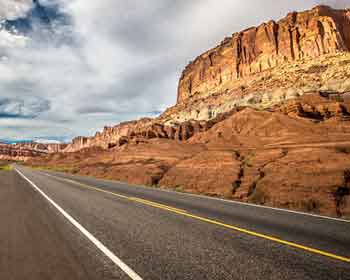Top Tips for Road Trips

Top 9 tips for your road trip
We take you through the best way to prepare your vehicle for your next road trip to allow for a safe, and comfortable trip.
There’s nothing quite like getting out on the road and escaping the city for a week or two. A road trip can be a lot of fun, but failure to properly prepare can quickly turn your road trip into a nightmare…
Poorly prepared cars can cause unwanted headaches, there’s risk of tyre failure, not to mention all of the little things that can go wrong. So, before you get behind the wheel, check out our top tips for road trips.
Top 9 Tips:
4) Drive to the road’s conditions
6) Be aware of other road users
7) Inspect anything you’re towing
9) Take a break
1) Inspect your tyres
We recommend you keep a good close eye on the condition of your tyres – not just when preparing for a road trip but all the time. Only one hand print of tread connects each tyre to the road and if they’re overly worn or incorrectly inflated they could cause you some trouble.We expose our tyres to some harsh conditions in Australia. Under-inflation is a major problem which can be controlled with regular tyre maintenance. An underinflated tyre will cause an increase in stress, concentrated on the sidewall of the tyre. These stresses result in heat build up which can lead to tyre damage and ultimately result in a blowout.
Under-inflation can also increase fuel consumption, tyre wear and braking distance. Bear in mind though, if you check your tyre pressures after you’ve been driving for a while the pressures will be higher, due to the air inside the tyres expanding when hot.
Don’t deflate your tyres; ensure you check your tyre pressures when they are cool.
2) Check your cooling system
It’s also worth giving your cooling system a good once-over before heading off on a road trip.Make sure you check your coolant levels and that your fan is working. You should be able to hear it running when driving and your temperature gauge shouldn’t move far past halfway. If it does, or it starts to rise suddenly when you’re driving, pull over immediately to see what might be the problem.
3) Pack what you need
It can be tempting when heading off on holidays to pack everything including the kitchen sink, but overloading your car can reduce its handling ability, and increase your fuel consumption.So, make sure you know what your car’s maximum payload is and don’t exceed it.
More than that, don’t load up your car so much that you can’t see out of the windows.
4) Drive to the road’s conditions
The surfaces of freshly sealed or older roads can have looser surfaces, especially when they heat up. Gravel flicking up from the road can cause damage to your car’s underbody or other vehicles’ windscreens.So, if the surface is loose, slow down and increase the distance between you and the car in front; you don’t want to get a cracked windscreen.
5) Prepare for the glare
Make sure your windscreen is in good condition and clean, that your windscreen washer bottle is full and your wipers are in good condition.Also make sure you’ve got a decent pair of sunglasses, preferably with polarized lenses for long distance driving, especially if you’re driving in summer. A quality pair of sunnies are a must have, because nothing tires you out like squinting behind the wheel. If the glare gets too bad, you could even momentarily lose sight of the cars in front.
And make sure you’ve got plenty of water in the car when you’re driving, because drying out can increase fatigue.
6) Be aware of other road users
If you’re heading to a popular holiday spot, it can feel like every man, woman, child and their dog is out in their cars, on their bikes, or even their skateboards! This means you’ve got to be extra careful when on the road.Always scan the road ahead, to the side and the rear, for other cars and particularly motorcycles. Never rely only on your mirrors; always perform a shoulder check.
Oh, and don’t ever, ever use your phone when you’re driving, place it in the glove box out of reach.
7) Inspect anything you’re towing
If you’re hauling the family caravan, camper trailer or boat on your holiday, make sure you’ve thoroughly checked over your rig before hitting the road.Just as it’s important to check the tyres on your car, it’s also vitally important you check your tyres on whatever you’re towing. Why? Well, they’re often sitting around in one spot for months on end, which can lead to flat spots on the tyre. This will result in a vibration for the first few km’s of your journey but should return to normal as the tyre regains its shape. However this damage can be permanent if the tyres haven’t moved in a really long time.
You’ll also want to make sure the bearings and brakes are up to scratch, and that there’s no mould on the vinyl of the pop-top if you’ve got a pop-top caravan. It’s worth it if you haven’t had your caravan or camper trailer out in a while, to take it to a caravan mechanic for a thorough once-over.
8) Always check your spare
It’s one thing to give your tyres a regular visual inspection, but don’t neglect your spare tyre.Some new cars don’t even have a spare, they have an inflation kit. If your car does have a spare tyre get it out and take a good look at it, check the pressure and inflate it if need be. Check your tool kit while you’re there, too. It doesn’t hurt to carry a few extra bits and bobs like spare fuses.
9) Take a break
You’ve all seen the roadside signs about fatigue and some of you may have ignored them. Don’t.Plan longer journeys so that you can take regular breaks (about every two hours) of around 20 minutes or so. Stop at a park and go for a walk or a jog, anything to get the blood flowing again. Even have a short nap, but make sure your car is parked somewhere safe when you do that.
Follow us on Facebook.

A little bit of preparation can make your next road trip a dream rather than a nightmare. Here are a few top tips for your next road trip.




